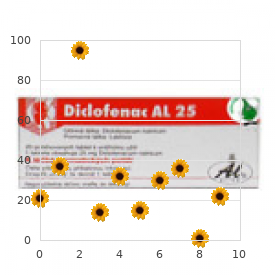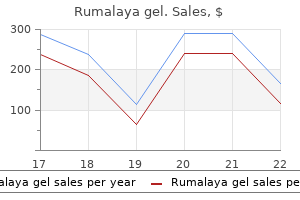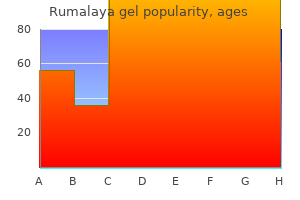
Rumalaya gel
| Contato
Página Inicial

"Rumalaya gel 30 gr with visa, spasms right upper quadrant".
I. Reto, M.A., M.D.
Co-Director, Rowan University School of Osteopathic Medicine
Treatment One of an important first steps in managing encephalitis is to contemplate treatable causes infantile spasms 9 month old rumalaya gel 30 gr order without prescription. Acyclovir (10 mg/kg intravenously each 8 hours in adults with normal renal function) must be administered to sufferers with encephalitis muscle relaxant home remedy 30 gr rumalaya gel purchase. Empirical remedy for acute bacterial meningitis must be initiated when clinical and laboratory testing is suitable with bacterial infection muscle relaxer 7767 order rumalaya gel 30 gr amex. If rickettsial or ehrlichial infections are suspected spasms with fever rumalaya gel 30 gr safe, empirical doxycycline should be administered. If a tumor is detected, elimination is essential as a result of it accelerates improvement and reduces relapses. Definition A brain abscess is a focal collection of contaminated material within the brain parenchyma that ends in a necrotic heart surrounded by inflammatory cells. PathologyandPathophysiology Brain abscesses produce symptoms and findings just like these of other space-occupying lesions. Commonly isolated pathogens are cardio and microaerobic streptococci and gramnegative anaerobes such as Bacteroides and Prevotella. On T1-weighted pictures, the world of cerebritis is seen initially as a low-signal-intensity, ill-defined space. T1-weighted images in the later levels of an infection present the formation of a rim of barely greater signal depth and central necrosis. Differentiating a brain abscess from tumor is necessary for the stereotactic method to ring-enhancing lesions earlier than biopsy or surgical excision. An abscess should be drained centrally, whereas a tumor ought to be biopsied along its rim. Surgical specimens are tradition constructive for 70% of antibiotic-treated patients and 95% of patients undergoing surgery before antibiotic administration. ClinicalPresentation the classic scientific picture is composed of parts reflecting the infectious nature of the lesion. Elements of one or two categories are sometimes absent in a given case, particularly early within the disease course. Recent onset of a headache is the most common symptom, which may increase in severity associated with focal signs related to the location of the abscess. Toxoplasma abscesses are sometimes related to movement issues due to their propensity for the basal ganglia. The period of evolution could additionally be as brief as hours or as lengthy as days to weeks with extra indolent organisms. Unless the surgical process poses a substantial risk, aspiration of the lesion is required for microbial diagnosis. If therapy of cerebral edema is necessary, high-dose intravenous dexamethasone (16 to 24 mg/day in four divided doses) may be used for brief periods till surgical intervention is possible. Corticosteroids could retard formation of a capsule across the brain abscess and the immune response to an infection. Seizures should be controlled because the tonic section of a generalized seizure could improve intracranial pressure. Lumbar puncture within the setting of a mass lesion carries the risk of transtentorial herniation. Because the mind abscess is seeded from a peripheral website of an infection, a search for other sites of an infection may help to establish the causative organisms and determine adequate treatment. Chapter ninety Infections of the Central Nervous System cortical or temporal lobe abscesses. If the organism is unknown, empirical remedy might embody vancomycin, metronidazole, and a third-generation cephalosporin. In brain stem abscesses, the potential of Listeria an infection ought to be thought-about, and therapy should include intravenous ampicillin. An important facet of the management strategy is eradication of the predisposing situation or reason for the brain abscess, corresponding to an oral, ear, cardiac, or pulmonary an infection. Nuchal rigidity and obtundation happen in meningitis and subdural empyema, but papilledema and lateralizing deficits are extra widespread in empyema. Diagnosis Lumbar puncture must be averted in sufferers with subdural empyema to forestall cerebral herniation. Treatment Treatment requires prompt surgical drainage of the empyema cavity and high-dose intravenous antibiotics directed at organisms discovered on the time of craniotomy. SubduralEmpyema Definition Subdural empyema refers to infection within the space separating the dura and arachnoid. Pathology and Pathophysiology Two thirds of subdural empyemas end result from frontal or ethmoid sinus infections, 20% from inner ear infections, and the remainder from trauma or neurosurgical procedures. The empyema is attributable to direct or oblique extension from contaminated paranasal sinuses through a retrograde thrombophlebitis. Unilateral empyema is commonest because the falx prevents passage throughout the midline, however bilateral or a quantity of empyemas can occur. Cortical venous thrombosis or brain abscess develops in about one fourth of patients. In some patients, the subdural empyema could also be associated with an epidural abscess or meningitis. Clinical Presentation Initial signs are attributable to continual otitis or sinusitis with superimposed lateralized headache, fever, and obtundation. If untreated, obtundation PathologyandPathophysiology Infections of the epidural space originate from contiguous spread or by way of hematogenous routes from a distant supply. Cutaneous infection, significantly within the back, is the most common remote supply, particularly among injection drug customers. As using epidural catheters has elevated for pain management, epidural abscess and hematoma have been more and more reported. Because the scale of the intravertebral canal stays relatively fixed however the circumference of the spinal cord adjustments, abscess formation is maximal within the thoracic and lumbar regions and minimal at the cervical backbone enlargement. Due to the loose connections between the dura and the bones of the backbone, the abscess can lengthen to a number of ranges, inflicting severe and intensive neurologic manifestations. Tuberculous abscesses may happen in as many as 25% of sufferers in highrisk populations. These patients must be monitored intently, and if indicators of neurologic deterioration emerge, surgical intervention could additionally be essential. ClinicalPresentation the traditional triad of fever, spinal ache, and neurologic deficits will not be identified in all sufferers, leading to a delay in diagnosis. An essential physical discovering is focal tenderness over the affected spinous processes. The pain may be mistaken for sciatica, a visceral stomach course of, chest wall pain, or cervical disk disease. If it goes unrecognized at this stage, the symptoms can evolve over a quantity of hours to a number of days to weakness, lack of lower extremity reflexes, and paralysis distal to the spinal degree of the an infection. In this clinical setting, spinal epidural abscess must be assumed, systemic antibiotics begun, and pressing neuroradiologic imaging pursued. Symptoms embody headache or lateralized facial pain, adopted in a few days to weeks by fever and involvement of the orbit. In some situations, sensory dysfunction happens in the first and second divisions of the trigeminal nerve together with a decrease in the corneal reflex. Further involvement of the contiguous orbital contents follows, with mild papilledema and decreased visual acuity that generally progresses to blindness. Extension to the opposite cavernous sinus or to other intracranial sinuses with cerebral infarction or elevated intracranial stress as a end result of impaired venous drainage may end up in stupor, coma, and demise. The differential prognosis includes transverse myelitis, intervertebral disk herniation, epidural hemorrhage, and metastatic tumor. Epidural abscess is often accompanied by diskitis or osteomyelitis of the vertebral bodies. Treatment Unless culture and sensitivities dictate in any other case, a penicillinaseresistant penicillin should be started empirically as antistaphylococcal treatment for presumed bacterial infection. Radiologic evaluation consists of imaging of the sphenoidal and ethmoidal sinuses, which can require drainage if infected.


X Endocrine Disease and Metabolic Disease 62 Hypothalamic-PituitaryAxis Kawaljeet Kaur and Diana Maas Theodore C gastric spasms symptoms 30 gr rumalaya gel with amex. It weighs roughly 600 mg and consists of three lobes spasms from coughing order 30 gr rumalaya gel mastercard, the adenohypophysis (anterior lobe) spasms sternum rumalaya gel 30 gr proven, the neurohypophysis (posterior lobe) spasms that cause shortness of breath rumalaya gel 30 gr cheap without a prescription, and the intermediate lobe. The infundibular stalk, which incorporates the portal plexus circulation, connects the hypothalamus to the pituitary gland. The pituitary gland is surrounded by essential constructions that can be compromised by its enlargement, including the optic chiasm, located superior to the gland, and the cavernous sinuses, situated on either side of the gland. These hormones are regulated by stimulatory and inhibitory peptides produced inside the ventral hypothalamus and are transported to the anterior pituitary gland by the infundibular portal system. These neurohypophyseal hormones are synthesized by the supraoptic and paraventricular nuclei of the hypothalamus and transported to the posterior lobe in neurosecretory granules along the supraopticohypophyseal tract. On imaging research, the traditional adult pituitary gland has a flat superior border and a vertical top of roughly eight to 10 mm. During periods of elevated hormonal activity, most notably throughout pregnancy, the pituitary gland can increase in dimension and change shape. Most pituitary tumors are gradual rising, but some have larger progress charges and could be invasive. Tumors which are smaller than 10 mm in diameter are known as microadenomas, whereas lesions 10 mm or bigger are known as macroadenomas. Pituitary tumors may be composed of any of the anterior pituitary cell types, with multiple cell sorts forming plurihormonal tumors or nonsecretory tumors. Table 62-2 critiques the prevalence of the varied pituitary tumors, and Table 62-3 describes the screening checks used to determine the secretory standing of a new pituitary tumor. The clinical manifestations of pituitary tumors are usually indicators and signs brought on by hormone overproduction or underproduction or mass impact. Common medical features of pituitary mass effect embody headaches, visual subject defects, and cranial nerve palsies. Compromise of normal pituitary tissue by a tumor can cause hormone loss or hypopituitarism. Prolactin synthesis and secretion by pituitary lactotrophs is under tonic inhibitory control by hypothalamicderived dopamine, which retains prolactin at its basal levels. Hyperprolactinemia, regardless of the etiology, can cause hypogonadism by way of its inhibitory effect on gonadotropin release, infertility, galactorrhea, and/or bone loss from the hypogonadism. Prolactinomas and hyperprolactinemia are more widespread in girls, with a peak prevalence between 25 and 35 years of age. The imply prevalence of patients medically handled for hyperprolactinemia is roughly 20 per one hundred,000 in men and approximately ninety per a hundred,000 in women. ClinicalPresentation the clinical presentation of a prolactinoma varies with the age and gender of the patient. Typically, the affected person is a young girl with menstrual irregularities, galactorrhea, and infertility. Typically, nonetheless, their tumors are diagnosed after signs of tumor compression seem, together with headache, neurologic deficits, and imaginative and prescient adjustments. Because of the early presentation of menstrual irregularities in girls, microprolactinomas are extra common in ladies; macroprolactinomas are more frequent in men and in postmenopausal ladies. The hook impact is an assay artifact that happens when very high serum prolactin concentrations saturate antibodies in the standard two-site immunoradiometric assay, leading to falsely lower ranges. This artifact can be overcome by repeating the prolactin measurement on a 1: a hundred serum sample dilution. Physiologic will increase in prolactin happen with pregnancy, physical or emotional stress, exercise, and chest wall stimulation. Other causes for hyperprolactinemia include some medicine, such as metoclopramide and risperidone, that can enhance prolactin to larger than 200 ng/mL. Mild to moderate hyperprolactinemia (25 to 200 ng/mL) within the presence of a bigger pituitary mass is more prone to be caused by a non�prolactin-secreting tumor with infundibular stalk compression and inhibition of dopamine transport to the lactotroph. Other causes embrace hypothalamicpituitary problems, systemic disorders, and neurogenic and idiopathic etiologies. TreatmentandPrognosis Medical administration with a dopamine agonist-bromocriptine or cabergoline-is the beneficial treatment. The dopamine agonists normalize prolactin, decrease tumor dimension, and restore gonadal operate in additional than 80% of patients with prolactinomas. Cabergoline, the newer agent, is most popular to other dopamine agonists as a result of it has higher efficacy in normalizing prolactin levels and shrinking tumor size and has fewer side effects. The most typical side effects seen with dopamine agonists are nausea, vomiting, orthostatic lightheadedness, dizziness, and nasal congestion. A prolactin stage greater than 250 ng/mL normally signifies the presence of a prolactinoma. Two kinds of artifacts can happen throughout the standard measurement of prolactin: the presence of macroprolactin and the hook impact. The estimated incidence of macroprolactin accounting for a significant proportion of hyperprolactinemia is 10% to 20%. Once the dopamine agonist is discontinued, prolactin ranges must be checked each three months for 1 12 months and then yearly. Recurrence risk after drug withdrawal ranges from 26% to 69% and is predicted by the initial prolactin level and tumor dimension. Additional side effects in youngsters embody slipped capital femoral epiphysis and hydrocephalus. The incidence of hypopituitarism 10 years after irradiation of the sellar region is roughly 50%. Treatment typically requires the utilization of a quantity of modalities to obtain enough control of the disease. Primary therapy is nearly all the time transsphenoidal surgical procedure, with the cure fee being directly proportional to tumor measurement. Additional therapy choices embody major medical therapy or major surgical debulking of the tumor followed by medical remedy for hormonal control and/or radiation therapy for treatment of residual tumor. Focused single-dose gamma knife radiotherapy has a 5-year remission price of 29% to 60%. Hypopituitarism is seen in additional than 50% of patients within 5 to 10 years after radiotherapy. The incidence of acromegaly is about 2 to 4 per million inhabitants, and the imply age at prognosis is 40 to 50 years. Clinical Presentation Acromegaly is a uncommon illness, and the speed of change of signs and signs is slow and insidious. Characteristic scientific findings of this disease embrace physical changes of the bone and gentle tissue and with multiple endocrine and metabolic abnormalities Table 62-4). Presenting signs can be the end result of a mass effect of the tumor or, mostly, there are symptoms and indicators of hyperthyroidism, including weight loss, tremors, warmth intolerance, and diarrhea. Many times, these tumors are initially misdiagnosed as main hyperthyroidism and patients are mistakenly treated with radioactive iodine. Treatment and Prognosis Surgery (transsphenoidal resection) is the first-line remedy and should be performed by an skilled neurosurgeon. Most sufferers do well and obtain management of symptoms of thyrotoxicosis in addition to reduction in tumor burden. Pathology Hypopituitarism due to encroachment of a tumor on the normal pituitary can cause deficiency of a quantity of pituitary hormones. Radiation treatment of the pituitary gland can even trigger hypopituitarism over time. Clinical Presentation the standard signs and symptoms of hypothyroidism are weight achieve, fatigue, cold intolerance, and constipation. If the condition is attributable to an underlying sellar tumor, signs of mass effect can also be present, relying on the scale of the tumor. The differential prognosis includes euthyroid sick syndrome, which is commonly seen within the setting of an acute illness. Treatment and Prognosis Management focuses on replacement of the thyroid hormones, as in main hypothyroidism. Underlying adrenal insufficiency ought to always be excluded and treated earlier than treatment of secondary hypothyroidism to keep away from precipitating an adrenal disaster. Secondary or tertiary adrenal insufficiency is mostly iatrogenic, triggered by method of steroids for different illness processes. Mineralocorticoids are normally not needed in sufferers with central adrenal insufficiency. Both primary and secondary adrenal insufficiency are characterized by weight reduction, fatigue, muscle weakness, orthostatic signs, nausea, vomiting, diarrhea, and abdominal pain.

Brief paroxysms of severe esophageal spasms xanax buy 30 gr rumalaya gel mastercard, stabbing spasms below breastbone rumalaya gel 30 gr trusted, unilateral ache radiate from the throat to the ear or vice versa and are incessantly initiated by stimulation of specific "trigger zones" spasms parvon plus 30 gr rumalaya gel buy visa. Swallowing often provokes an assault; yawning muscle relaxant used by anesthesiologist discount rumalaya gel 30 gr otc, speaking, and coughing are different potential triggers. PostherpeticNeuralgia Herpes zoster produces head pain by cranial nerve involvement in one third of instances. In some instances a persistent intense burning ache follows the initial acute illness. The discomfort may subside after several weeks or persist (particularly in the elderly) for months or years. The ache is localized over the distribution of the affected nerve and associated with beautiful tenderness to even the lightest contact. Conservative remedy consists of the use of anti-inflammatory medicine, cervical immobilization, and physical therapy for isometric strengthening of neck muscular tissues once pain has subsided. There is some proof to counsel that cervical spondylosis is an lively degenerative illness quite than simply the process. Furthermore, early studies with the glutamate antagonist riluzole suggest a possible role in decreasing illness progression. Acute low again ache lasting several weeks is often self-limiting, with a low threat for serious everlasting disability. Risk factors for prolonged incapacity embrace psychological distress, compensation conflict over work-related damage, and other coexistent pain syndromes. The analysis of sufferers with acute low back ache ought to concentrate on distinguishing ache of mechanical origin from neurogenic pain brought on by nerve root irritation. The similar pathologic modifications that affect the cervical backbone may also have an result on the lumbar spine. Because the spinal twine ends at the degree of the primary lumbar vertebra, lumbar canal stenosis from intervertebral disk illness and degenerative spondylosis will have an result on the roots of the cauda equina. The most typical levels for lumbar degenerative disk illness are at L4 to L5 and L5 to S1, resulting in the common complaint of sciatica caused by irritation of the decrease lumbar roots. Pain tends to enhance with sitting or mendacity down, in contrast to the pain from spinal or vertebral tumors, which is aggravated by prolonged recumbency. Examination reveals lack of the traditional lumbar lordosis, paraspinal muscle spasm, and exacerbation of ache with straight leg rising, owing to stretching of the decrease lumbar roots. About 10% of disk herniations happens lateral to the spinal canal, in which case the extra rostral root is compressed. Percussion of the backbone might elicit focal tenderness of one of many vertebrae, suggesting bony infiltration by an infection or tumor. Patients with danger elements for malignancy, an infection, or osteoporosis, as nicely as these with ache maximal at relaxation (or nocturnal pain) require imaging. Patients with primary and metastatic tumor can current with acute again pain (Chapter 119). Treatment methods for lumbar ache are much like these for cervical pain, with surgical procedure reserved for patients with neurologic indicators and clear pathologic processes seen on imaging research. Most circumstances of acute low again ache, even with rupture of an intervertebral disk, may be handled conservatively with a brief period of relaxation, muscle relaxants, and analgesics. Patient training regarding correct posture and applicable back workouts is useful, as is a proper physical therapy program. For a deeper discussion on this subject, please see Chapter 398, "Headaches and Other Head Pain," in Goldman-CecilMedicine, 25th Edition. Headache Classification Subcommittee of the International Headache Society: the International Classification of Headache Disorders: 3rd edition, Cephalalgia 33:629�808, 2013. Counihan also wants to be examined using Ishihara colour plates; even when visual acuity is normal, sufferers with lesions of the optic nerve might complain that colors seem "washed out" in the affected eye. The area must be examined first unilaterally and then bilaterally as a outcome of uncovering a defect (particularly within the left hemifield) with bilateral testing solely (extinction) suggests a lesion within the contralateral parietal lobe. Partial or complete visible loss in a single eye solely implies harm to the retina or optic nerve anterior to the optic chiasm, whereas a visual subject abnormality involving each eyes implies a defect at or posterior to the optic chiasm. Scotomas are areas of partial or complete visual loss and could additionally be central or peripheral. Field defects are said to be homonymous if the identical part of the visible area is affected in both eyes; a homonymous hemianopia implies a postchiasmal lesion. Quadrantanopias are smaller defects within the visible field and could additionally be superior (which suggests a temporal lobe lesion) or inferior (which suggests a parietal lobe lesion). Pupils Examination of the pupils ought to begin with observation of papillary size and shape at relaxation. The smallest line the affected person can read is documented as the visible acuity; as an example, acuity of 20/40 refers to letters that the affected person sees maximally at 20 ft, which a normal individual can see at 40 feet. When errors of refraction are liable for decreased visible acuity, imaginative and prescient could also be improved by having the affected person look by way of a pinhole. Corrected imaginative and prescient in a single eye of less than 20/40 suggests injury to the lens (cataract) or retina or a disorder of the anterior visual (prechiasmal) pathway. If the stability of those systems is disrupted, anisocoria (unequal pupil size) outcomes. If the anisocoria increases going from dim to bright mild, a lesion of the parasympathetic system is in all probability going. Both the direct and consensual mild responses must be noted for every eye; in the latter, when the sunshine is shone in a single eye, each pupils should constrict. This is best examined using the "swinging mild take a look at," by which the sunshine is moved shortly from one eye to the other. Argyll-Robertson pupils are small, irregular pupils that constrict to close to imaginative and prescient (accommodation reflex) but not in response to mild. This so-called light-near dissociation may occur in rostral dorsal midbrain lesions, during which there could also be related abnormalities of vertical gaze, eyelid retraction, and convergence retraction nystagmus (Parinaud Syndrome). This uncommon constellation of medical findings is regularly famous in patients with lesions of the pineal gland. A giant, unreactive pupil with ptosis signifies a lesion of the oculomotor nerve (third cranial nerve palsy) interrupting the parasympathetic nerve provide to the pupil. The related paralysis of the medial and inferior rectus and inferior oblique muscles (see later discussion) results in distortion of the eye (inferolaterally, "down and out") and a subjective criticism of diplopia by the patient. Common causes of a third nerve palsy embody compression by an aneurysm of the posterior communicating artery by transtentorial herniation, or from ischemia, usually in the setting of diabetes or vasculitis. A third nerve palsy brought on by ischemia usually spares the pupil however leads to complete paralysis of the oculomotor and eyelid levator muscles. Acute painful third nerve palsy must be treated as an emergency, with the need to investigate for an intracranial aneurysm. A small, poorly reactive pupil with related ptosis is identified as Horner syndrome and outcomes from damage to the sympathetic fibers to the pupil, which may occur anyplace along their course from the hypothalamus, brainstem, and ascending sympathetic chain from the superior cervical ganglion to the orbit. There may be associated unilateral anhidrosis ensuing from damage to sympathetic fibers. Horner syndrome could be the first sign of an apical lung tumor (Pancoast) or could happen in diseases affecting the carotid artery. This is usually an incidental finding on examination but may be associated with areflexia (Holmes-Adie syndrome). Reaction to lodging is preserved, and it has been advised that the disorder is a results of parasympathetic denervation. Is the diplopia primarily horizontal or vertical, or is it larger trying to the right or to the left Greater problem with close to imaginative and prescient suggests impairment of the medial rectus, oculomotor nerve, or convergence system, whereas abducens nerve weak point ends in horizontal diplopia when objects are seen at a distance. Monocular diplopia is usually brought on by illnesses of the retina or lens and is corrected by having the patient look through a pinhole, until the cause is psychogenic. The examination should start by figuring out the position of the pinnacle and eyes with the eyes in main gaze. Pursuit eye movements: Smooth pursuit eye actions allow fixation on a transferring object. Ask the patient to observe a moving goal such as a pin in all instructions of gaze. Saccadic eye actions: these actions enable speedy switching of gaze from one target to another.
Purchase rumalaya gel 30 gr online. Skeletal muscle relaxants:tut5( dantrolene-directly acting skeletal muscle relaxants).

